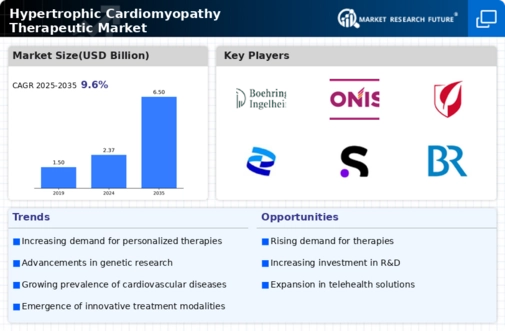Increased Awareness and Education
The heightened awareness and education surrounding hypertrophic cardiomyopathy are crucial drivers for the Hypertrophic Cardiomyopathy Therapeutic Market. Initiatives aimed at educating healthcare providers and patients about HCM are gaining traction, leading to earlier diagnosis and intervention. This increased awareness is likely to result in a higher number of patients seeking treatment, thereby expanding the market. Additionally, patient advocacy groups are playing a vital role in disseminating information and supporting research efforts, further contributing to the growth of the market. As more individuals become informed about the symptoms and risks associated with HCM, the demand for effective therapeutic options is expected to rise, positively impacting the Hypertrophic Cardiomyopathy Therapeutic Market.
Advancements in Therapeutic Options
The Hypertrophic Cardiomyopathy Therapeutic Market is witnessing a surge in advancements in therapeutic options, which is likely to enhance treatment outcomes for patients. Recent developments in drug therapies, including myosin inhibitors and gene therapies, have shown promise in clinical trials, potentially transforming the management of HCM. The introduction of these novel therapeutics may lead to improved patient compliance and better overall health outcomes. Additionally, the market is seeing an increase in combination therapies that target multiple pathways involved in HCM, further broadening the treatment landscape. As these innovative therapies gain regulatory approval and enter the market, they are expected to drive growth in the Hypertrophic Cardiomyopathy Therapeutic Market, providing patients with more effective and personalized treatment options.
Regulatory Support for Innovative Therapies
Regulatory support for innovative therapies is emerging as a key driver for the Hypertrophic Cardiomyopathy Therapeutic Market. Regulatory agencies are increasingly recognizing the need for expedited approval processes for novel treatments that address unmet medical needs in HCM. This supportive regulatory environment is likely to encourage pharmaceutical companies to invest in research and development of new therapies. Additionally, initiatives such as breakthrough therapy designations and fast-track approvals are facilitating quicker access to innovative treatments for patients. As a result, the Hypertrophic Cardiomyopathy Therapeutic Market is expected to experience accelerated growth, with a steady influx of new therapies entering the market to meet the needs of patients suffering from this condition.
Growing Investment in Cardiovascular Research
Investment in cardiovascular research is a significant driver for the Hypertrophic Cardiomyopathy Therapeutic Market. Increased funding from both public and private sectors is facilitating the exploration of new therapeutic avenues for HCM. Research initiatives focusing on the genetic and molecular underpinnings of HCM are likely to yield novel insights, leading to the development of targeted therapies. Furthermore, collaborations between academic institutions and pharmaceutical companies are becoming more prevalent, fostering innovation in treatment strategies. This influx of investment not only accelerates the pace of research but also enhances the potential for breakthroughs in the management of HCM. As a result, the Hypertrophic Cardiomyopathy Therapeutic Market stands to benefit from a robust pipeline of new therapies emerging from ongoing research efforts.
Rising Prevalence of Hypertrophic Cardiomyopathy
The increasing incidence of hypertrophic cardiomyopathy (HCM) is a pivotal driver for the Hypertrophic Cardiomyopathy Therapeutic Market. Recent estimates suggest that HCM affects approximately 1 in 500 individuals, indicating a substantial patient population requiring therapeutic interventions. This rising prevalence is likely to spur demand for innovative treatment options, including pharmacological therapies and surgical interventions. As awareness of HCM grows among healthcare professionals and patients alike, the market is expected to expand significantly. Furthermore, the aging population, which is more susceptible to cardiovascular diseases, contributes to the increasing number of diagnosed cases. Consequently, the Hypertrophic Cardiomyopathy Therapeutic Market is poised for growth as healthcare systems adapt to meet the needs of this expanding patient demographic.


















Leave a Comment